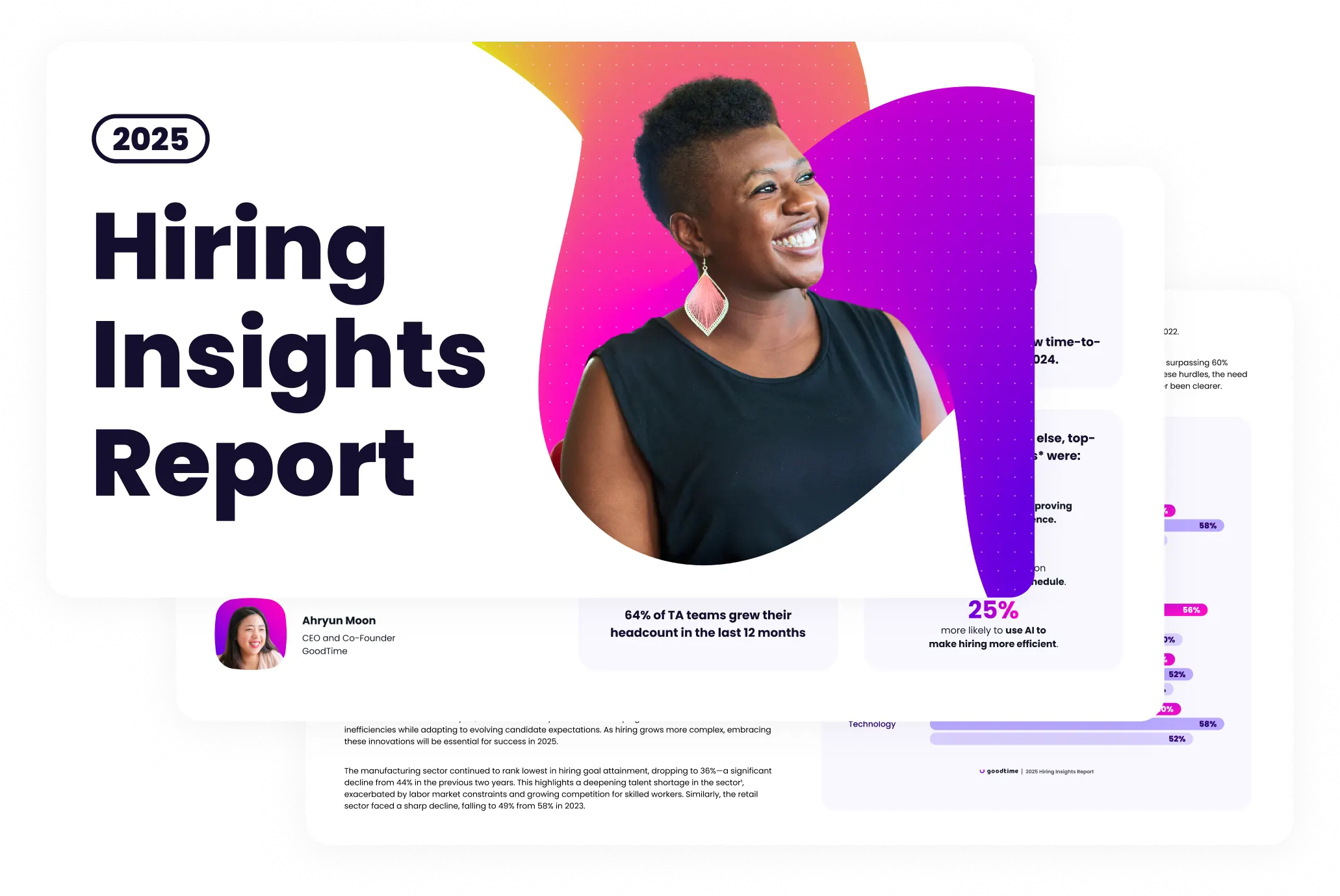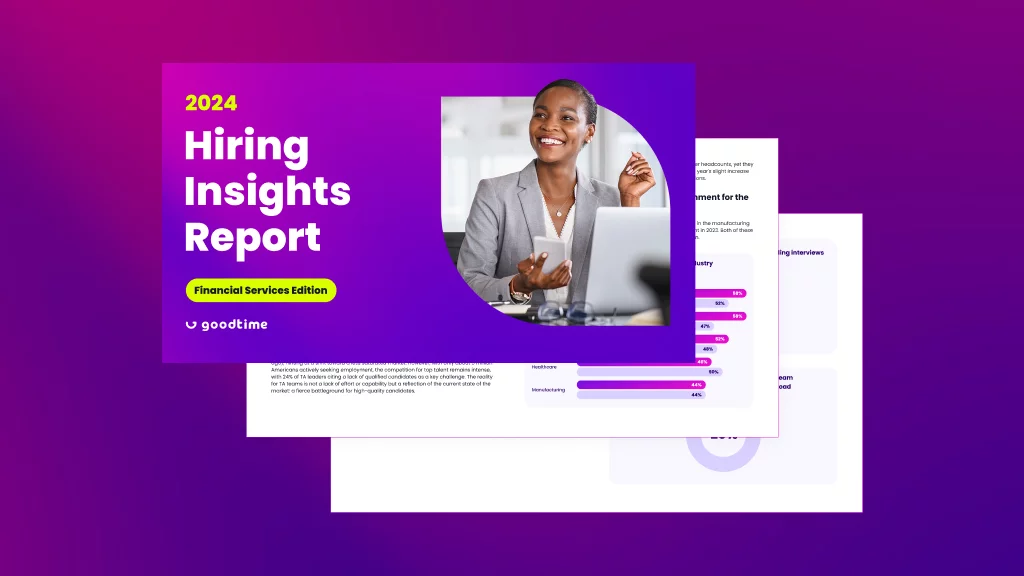Table of Contents
Talent operations pros are quickly becoming the stars of the HR function, especially in enterprise recruitment — and for good reason.
According to SHRM’s HR Benchmarking Report, companies spent an average of $4,683 per new employee hire, and a generous $28,329 per executive hire. With such a large investment in talent, it’s vital to make sure those efforts bear fruit and secure the best possible employees. That means recruiting teams need to operate at maximum efficiency — and that’s what talent operations, sometimes called recruiting operations is all about.
But what exactly do these terms entail? And why are they increasingly crucial given today’s economic climate? In this guide, we’ll examine what makes these functions so important — and how they have changed with the times, and with technology.

Unlock 2025’s top hiring strategies: Insights from 500+ TA leaders
Be the first to uncover deep hiring insights specific to your sector — straight from the highest-performing TA teams.

The evolution of talent and recruiting operations
Historically viewed as administrative roles, talent operations and recruiting operations were traditionally limited to basic HR tasks and were rarely involved in strategic business decisions.
However, the digital revolution and the shift to knowledge-based economies have transformed these roles into key strategic partners, shaping a workforce that aligns with evolving business needs. Several technological and sociological trends are driving this transformation.
The shift from paper-based to digital systems in HR, marked by the adoption of HR Information Systems (HRIS) and Human Capital Management (HCM) systems, has significantly enhanced efficiency and accuracy in HR processes.
Technology has informed change. One of the earliest HR innovations, Applicant Tracking Systems (ATS), revolutionized recruitment by automating applicant tracking and management. Platforms like Monster, Indeed, and LinkedIn have expanded talent acquisition reach, allowing for broader and more efficient candidate sourcing.
Talent management platforms offer a comprehensive approach to managing the employee lifecycle, including performance management and career development. The use of data analytics and metrics have enabled HR to make more strategic, data-driven decisions, enhancing various aspects of HR management. Platforms to track employee satisfaction and productivity help to reduce turnover.
Other technological advances have included the use of artificial intelligence and machine learning for tasks such as resume screening, predicting turnover, and conducting preliminary interviews.
Remote Working tools such as Zoom, Slack, and Microsoft Teams support the growing trend of remote and hybrid work models. Automated interview scheduling systems have made everyone’s life easier.
Diversity and inclusion initiatives aim to shape a more diverse and inclusive workplace, including targeted recruiting strategies and internal policies. Focusing on mental health, work-life balance, and physical health, Employee Wellness Programs are becoming integral to employee well-being.
Meanwhile, outsourcing to professional employer organizations (PEOs) allows smaller organizations to access advanced HR expertise and technology.
These innovations have not only streamlined HR operations but have also repositioned HR as a strategic function that enhances the employee experience and contributes to organizational success.
Key components of talent and recruiting operations
Talent acquisition, development, and retention
The core of talent operations lies in not just acquiring the right candidates but also in nurturing and retaining them. This involves three overlapping, and related HR functions: talent acquisition, development, and retention.
Acquisition refers to the process of identifying, attracting, and hiring skilled individuals to meet organizational needs. Talent Operations is proactive and strategic, focusing not just on filling current vacancies but also on building a talent pipeline for future needs.
Development involves activities and processes aimed at enhancing the skills, knowledge, and competencies of employees. Talent development includes training programs, mentoring, coaching, and providing opportunities for professional growth and career advancement.
Significant focus is placed on keeping employees satisfied, rather than suspecting that the “grass is greener” elsewhere. Retention is the practice of keeping and engaging employees in an organization for as long as possible. Common talent strategies include offering competitive compensation and benefits, providing career development opportunities, and recognizing employee success.
Recruitment analytics and strategies
Recruitment analytics refers to the methodical analysis of data related to the hiring process. This approach utilizes various metrics and algorithms to optimize recruitment strategies and processes.
Key aspects of recruitment analytics include tracking recruitment metrics like time-to-fill, cost-per-hire, source of hire, candidate experience, and quality of hire.
By analyzing this data, organizations can gain insights into the effectiveness of their recruiting efforts, build stronger recruiter capacity models, identify areas for improvement, and make better data-driven decisions.
The role of data and analytics
Data-driven decisions are revolutionizing talent operations and recruitment management. By utilizing metrics like time-to-hire, employee turnover rates, and candidate satisfaction scores, organizations can make informed decisions that significantly improve their talent operations.
A common thread running through modern organizations’ use of technology for recruitment is that it handles the “grunt work,” freeing up consultants to add the personal touch. As Jonathan Wall, founder of Cassillon.AI puts it, “We should be leveraging automation and AI to do those things that aren’t fun. Recruiting is a very defined process and a lot of what I call ‘administrivia,’ it’s the stuff that recruiters don’t like… They kind of keep us from doing the things that really are our superpowers.”
Here are some of the areas of talent recruitment and retention that data science is revolutionizing:
Data-driven recruitment
Analytics can identify the best channels for sourcing candidates, whether it’s job boards, social media, or employee referrals, by analyzing past success rates. Screening is a useful function for a date-driven approach too. Using data from resumes and application forms, machine learning algorithms can help shortlist candidates by matching skills and experience with job requirements.
AI can even predict a candidate’s job performance and likelihood of staying with the company based on historical data, thereby improving the quality of hires.
Enhancing candidate experience
Data enables personalization of the recruitment process, tailoring communication and interactions based on candidate preferences and behavior. Analytics can even help improve the experience for new hires. Analyzing candidate feedback can help in refining the recruitment process, making it more candidate-friendly and efficient.
Improving recruitment efficiency
The use of data analytics can highlight glitches and inefficiencies in the recruitment process, such as prolonged time-to-hire, allowing for targeted process improvements.
As Monika Warchol, Senior Manager of Global Talent Operations at OneStudy explains, “It’s important to start by getting crystal clear on the core problem. Lean on your data to identify where the bottlenecks really are in your process and go from there.”
As well as productivity gains, there are budget savings to enjoy as well. By examining the cost-per-hire and the effectiveness of different recruitment strategies, organizations can allocate resources more efficiently.
Join a community just for talent pros
GoodTime Talent Innovators is an online community for TA professionals to engage in discussions, network with one another, and discover exclusive events.

Employee retention strategies
Our Hiring Insights Report found that talent retention was the top struggle for TA teams.
Analyzing data related to employee turnover can help identify patterns and root causes of why employees leave, enabling targeted interventions. Surveys and feedback mechanisms, analyzed through data analytics tools, can provide insights into employee satisfaction and engagement levels.
Craig Pyke, Director of Talent Acquisition at Rivian, finds data invaluable in this respect. He told us, “When you combine exit survey data of why they’re leaving […] you can really start to pinpoint if that’s a TA challenge or if that’s a challenge somewhere within the business.”
When it comes to performance management, there’s a role for analytics here too. Data on employee performance can inform tailored development programs, career progression paths, and reward systems appropriate to each employee.
Predictive modeling for retention
AI models can predict which employees are at risk of leaving, allowing HR to proactively address their concerns or reasons for potential turnover. Personalization in terms of learning and development can help boost retention, and this is guided in informed with better employee performance and behavior data.
Workforce planning
It’s not just about what’s happening right now, either. Data analytics can forecast future workforce requirements, helping in planning recruitment and development initiatives in advance.
The identification of current skill gaps and prediction of future skill needs can help direct recruiting operations as well as shape internal training programs.
Best practices in talent and recruiting operations
Adopting best practices such as building a strong employer brand, implementing continuous feedback mechanisms, and utilizing predictive analytics can substantially enhance talent and recruiting operations.
Here are three successful case studies to consider:
IBM: identifying potential using AI
IBM has been at the forefront of using artificial intelligence in HR, particularly with their Watson Talent suite. They’ve implemented AI to assist in talent acquisition, using predictive analytics to assess candidates’ future performance and cultural fit.
This approach has streamlined their recruitment process, making it more efficient and effective. IBM emphasizes personalized learning experiences for its employees, using AI to offer tailored training programs and career development suggestions.
Siemens: tracking and developing talent
Siemens has innovated in talent acquisition and development by integrating digital tools and platforms into their HR processes. They use sophisticated applicant tracking systems and AI-based tools for candidate screening and selection.
The telecom company places a strong emphasis on continuous learning and skill development, offering a variety of digital learning platforms and programs for their workforce.
Walmart: focusing on staff development
Walmart has leveraged digital platforms and data analytics to enhance their recruitment processes. This includes using sophisticated applicant tracking systems to identify the best candidates for various roles, from in-store associates to corporate positions.
Walmart stands out for its investment in employee training and development programs. They have established Walmart Academies, which are dedicated facilities where employees receive training in skills ranging from leadership and soft skills to retail fundamentals and technology.
Challenges in managing talent and recruitment operations
Our Hiring Insights Report offers a comprehensive view of the challenges and innovations in talent acquisition for the year.
One of the standout findings is the widespread adoption of AI and automation by talent acquisition teams, with 99% of teams using these technologies to enhance their processes. This shift towards technology is a response to the challenging landscape faced by TA teams, characterized by stretched resources and the need for more efficient hiring processes.
Other significant trends identified include a focus on talent retention and internal mobility, the rise of multi-disciplined recruitment professionals, and the evolving role of employer branding and authentic engagement.
Our report also highlights the continued growth of global, remote, and hybrid work models, and shifts in market dynamics regarding pay and contract transparency.
Brenda Purvis, a consultant at Kaiser Permanente, notes “For the first time, professionals in healthcare are finding themselves in a position similar to those in other industries. They are now seeking flexibility, much like what has been common in the tech and corporate sectors for a long time, such as remote work and flexible work hours.”
The future of talent and recruiting operations
The top five talent acquisition trends in the coming decade are likely to include:
- Increased Use of Artificial Intelligence and Machine Learning: AI and ML will further permeate talent acquisition and management.
- Emphasis on Diversity, Equity, and Inclusion (DEI): Companies will use advanced analytics to ensure their hiring practices are unbiased and inclusive.
- Remote and Flexible Work Arrangements: The trend towards remote or hybrid work, accelerated by the COVID-19 pandemic, is likely to continue.
- Data-Driven Decision Making: The use of big data in HR will become more prevalent, with analytics playing a key role in strategic decision-making.
- Employee Experience and Wellbeing: There will be a growing focus on the overall employee experience, encompassing aspects like workplace environment, work-life balance, mental health, and professional development.
Recruitment and retention: a strategic focus
Talent and Recruiting Operations are more than just HR functions. They are strategic drivers of organizational success.
By understanding their evolution, embracing technology, and implementing best practices, organizations can not only overcome challenges but also thrive in the dynamic landscape of the future workplace.
As we step into an era where talent is the primary competitive differentiator, mastering these domains is not just beneficial; it’s essential.




